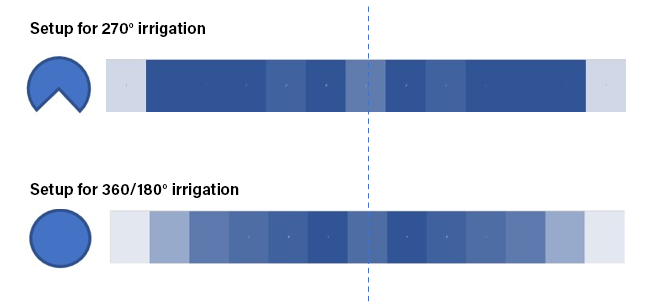Choosing The Perfect Angle
How do you actually set the stops on the gun to ensure the most even water distribution possible?
We therefore took the time in late summer to take some measurements.
The water distribution of an irrigation run naturally depends on the setting of the stops - we compared a full circle irrigation 360° or 180° with a 270° limit stop setting.
According to our analyses, the water distribution looks roughly as follows:
The 270° setting clearly allows more water to reach the outermost areas.
This does not really answer the question - which setting is "better"!
Intersection
Certainly, calculating water distribution must consider the "neighbouring runs," since the throw distance often exceeds half the working width. Consequently, with each operation, we irrigate a portion of the adjacent runs on both sides, which then "return this water" when they are irrigated.
When our water distributions for 360°/180° and 270° intersect at varying levels, it means that the settings of the stop angles are ultimately determined by the intersection area.
According to our measurements and our interpretation, this results in the following:
- If the area of intersection is small, it is useful to irrigate at 270° in order to get water into the outer areas (case 1)
- If we have a medium level of intersection, the two settings are quite similar (case 2)
- If there is a large intersection, irrigation should be done at 360°/180°, as otherwise too much water will be applied to the outer areas (case 3)
Clearly, these are our measurements and interpretations. To make scientifically sound statements, more comprehensive measurements and analyses would be necessary. Unfortunately, we do not have the time for such extensive research at this moment.
We can only report on what we have measured and our derived conclusions. Please take it with a grain of salt.
We would be delighted to hear your reactions, i.e. queries, criticisms, comments, additions and discussions!



